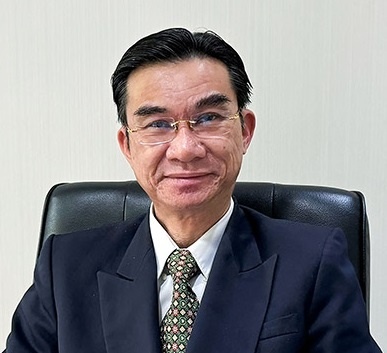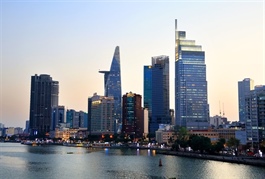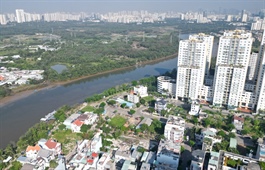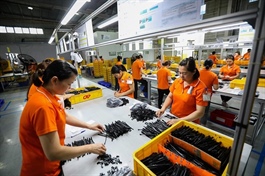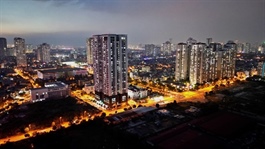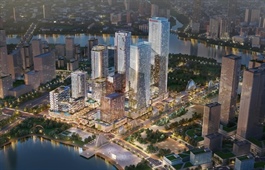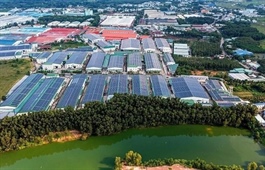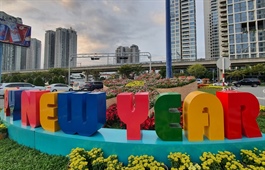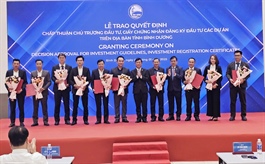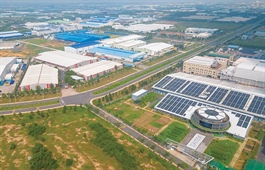Urban renewal initiatives to boost land use and growth
Urban renewal initiatives to boost land use and growth
Land expansions alongside new transport arteries are becoming a key opportunity to drive breakthroughs in real estate.
After more than a decade of development, Ho Chi Minh City’s metro line 1 began operations at the end of December. As the city’s first metro system, it represents a transformative leap: not just as a convenient public transport solution but also as a catalyst for a bold new approach to urban development amid the pressures of limited land and a booming population.
This approach is encapsulated in the transit-oriented development (TOD) model, which allows Ho Chi Minh City to experiment with innovative policies to address its urban challenges. The city has been authorised to pilot related initiatives while utilising public investment funds for land acquisition, compensation, and resettlement near metro stations and ring road 3 intersections.
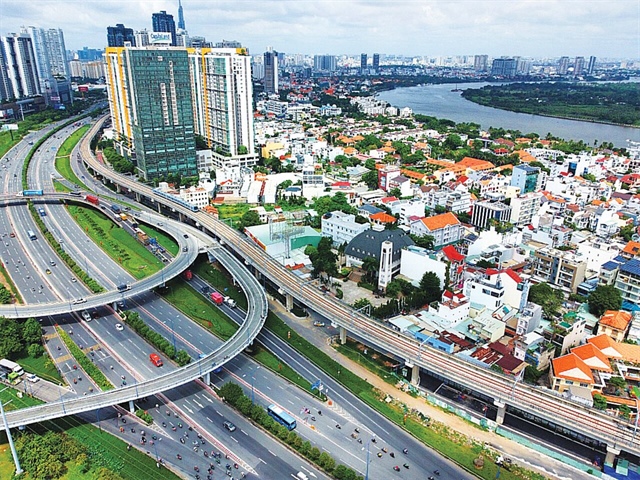
Urban renewal initiatives to boost land use and growth, photo Le Toan |
In line with this, Ho Chi Minh City People’s Committee has launched a plan to unlock the potential of land surrounding metro lines 1 and 2 and ring road 3 through the TOD framework. This approach aims to enhance flexibility in adjusting construction densities and infrastructure targets while maximising the value of land assets near metro hubs.
The strategy is designed not only to optimise land use, but also to generate additional funding for reinvestment in transportation infrastructure, creating a sustainable cycle of urban growth.
To ensure smooth execution, the People’s Committee has tasked relevant departments with outlining precise boundaries, legal statuses, and zoning plans for each area. Key tasks include determining urban development functions, revising zoning regulations, selecting suitable investors, and securing approvals.
TOD areas will be prioritised based on their potential for seamless implementation, including efficient land clearance, swift progress, high economic returns, and substantial revenue generation from land auctions and project bids to bolster the city’s budget.
Last year, Ho Chi Minh City began to pilot TOD development in nine key locations along metro lines and ring road 3. For metro line 1, the focus will be on the Phuoc Long Station area in the Thu Duc area of Ho Chi Minh City.
Meanwhile, metro line 2 will feature three sites: a plot in Tay Thanh, the Exhibition and Sports Centre in Tan Binh district, and the C30 site near Le Thi Rieng Station.
For ring road 3, several large parcels of land have been identified, including a coconut plantation and another area in the Long Binh section of Thu Duc, and plots in Hoc Mon district and elsewhere.
Field surveys revealed that many of these areas are prime real estate, with cleared land ready for development. A standout example is a large site near Phuoc Long Station along metro line 1, touted as Thu Duc’s golden land.
Once home to the Ha Tien cement plant and an inland container depot cluster, the area has undergone relocation and urban renewal, positioning it as a future urban model for Thu Duc, a beacon of what is to come as the city embraces TOD to its full potential.
According to experts, the planning and development of TOD to create compact urban centres will unlock new growth opportunities for the real estate market. These key transportation routes offer a chance for the city to modernise, revitalise urban spaces, generate additional revenue for the municipal budget, and enhance the quality of life for its residents.
For instance, ring road 3, which passes through Ho Chi Minh City, Dong Nai, Binh Duong, and Long An, has a total length of 76km. Of this, more than 47km traverses Ho Chi Minh City, running through Thu Duc, Hoc Mon, Cu Chi, and Binh Chanh districts.
Dr. Nguyen Minh Hoa, vice chairman of the Ho Chi Minh City Planning and Development Association, pointed out that as a megacity with an ever-increasing population, the city is facing significant pressure from land scarcity and overcrowding.
“Therefore, the strategy of developing land reserves along major transport infrastructure corridors is particularly relevant. However, in reality, the construction of many such roads has been slow, and related schemes remain absent,” Hoa said.
The development of land along transportation routes must pay special attention to urban planning, ensuring that the development of projects is synchronised with both technical infrastructure and social infrastructure, Hoa added.
“In developed countries, they don’t build isolated apartment complexes, but instead entire clusters of projects fully equipped with schools, markets, and healthcare facilities. If services are located far from where people live, such developments will struggle to attract residents,” said Hoa.
From the perspective of the real estate market, businesses believe that expanding land reserves along transportation routes will create fresh opportunities. Ngo Quang Phuc, CEO of Phu Dong Group, stated that securing land reserves has long been a major challenge for property developers.
“In recent times, businesses have had to source land independently, negotiate compensation, or purchase land reserves, facing significant challenges and risks, including uncertainty over land-use fees and market volatility. If the government creates clean, legal land reserves and opens them up to developers through auctions, it would mark a major shift for the market,” he said.
Likewise, Duong Minh Tien, CEO of Asia New Time, argued that while people often say Ho Chi Minh City lacks land, the real issue is the shortage of land with full legal approvals for development.
“In fact, there is still plenty of undeveloped land. If the TOD model is well implemented, it can effectively resolve urban transportation issues by creating efficient routes for residents to easily access urban amenities, including commerce, entertainment, and jobs,” Tien said.
Additionally, the TOD model can help meet housing demands in urban centres while increasing property values.
“For example, along metro line 1, particularly the Vo Nguyen Giap corridor, numerous well-designed projects have emerged. Compared to their launch prices, these undertakings have experienced significant price appreciation,” added Tien.
|
Dr. Pham Tran Hai, deputy head Urban Management Studies Ho Chi Minh City Institute for Development Studies
The TOD model is an important data for housing development. This is an objective phenomenon. Whether the state intervenes or not, areas around public transportation still tend to develop. However, when the state intervenes, the government’s role is to promote the positive aspects of this model, while ensuring the urban railway system operates effectively. We all know that almost all urban railways often suffer financial losses when considering operating costs alone, regardless of investment costs. However, in terms of overall economic and social value, these routes still bring great benefits if managed well. The state needs to intervene to more effectively exploit areas around public transportation routes. This not only helps increase land value but also organises space more reasonably, such as walking paths, public spaces and other amenities. The state’s role here is to establish a legal and policy corridor to balance development and negative impact management. Without intervention from the state, high-density areas with mixed functions are at risk of being overloaded. Economists have come up with solutions such as collecting fees from added value capture. This is a form of regulating added value from real estate and land surrounding public transport infrastructure. The Land Law 2014 has opened up a number of directions, such as people contributing capital in land and receiving real estate use rights in return. However, for effective implementation, there needs to be a legal corridor and clearer guiding circulars. State policies, if properly implemented, will create motivation for harmonious and sustainable urban development according to the TOD model, while overcoming negative impacts and ensuring benefits for the community. Vincent Choo Wing Sung, investment director Metro Star JSC
The pilot implementation of particular policies for development of Ho Chi Minh City since 2023 has opened up great opportunities for the TOD system, encouraging businesses to focus on developing project chains and low-carbon urban areas following the green system. If this continues to be well applied, investors like us can deploy dozens of projects along eight metro lines faster than initially proposed. The chain of low-carbon urban areas following the green TOD model will include green design, clean energy, low-carbon and carbon absorption construction materials, energy saving, especially high connectivity with other modes of electric trains and hydrogen buses to reduce 50 per cent of cars and motorbikes in a certain area. We hope that Ho Chi Minh City will be interested in supporting businesses that have participated in developing the first green TOD projects like Metro Star Investment to complete pilot models that can be then widely applied and institutionalised with legal and fair guidelines for all economic sectors. Regarding planning design, we suggest referring to the latest successful connection models: for example, electric trains or monorails passing through shopping centres, apartments, and office buildings, which is convenient for passengers and does not waste space above the train station like the current situation in Vietnam. It is not necessary to reserve too much land around the station for the system. |



